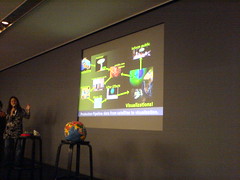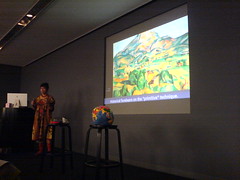From the node-l mailing list. I am going to post the press release, hopefully I will be able to make it there and see what actually happens.
Mark
——
Press Release
Snout
Making a stand about Climate Change
Using participatory sensing & media scavenging
A ‘carnival’ performance and public forum
__________________________________________________
Venue: Cargo, 83 Rivington St, Kingsland Viaduct, London, EC2A 3AY
The performance will start at Cargo and the route will include Hoxton Square and Hoxton Market
Dates/Times: Tuesday 10 April, Performance 10am, Conference 1.30-5pm.
Tube: Old St, Liverpool St
Admission: Free
Access: Limited, please call in advance for details
Information: +44 (0)20 7729 9616, www.iniva.org, institute@iniva.org
Supported by Arts Council England & Esmée Fairbairn
__________________________________________________
With increasing concerns about climate change, individuals and communities are looking for new ways to take action and make a real and lasting impact.
In the Snout ‘carnival’ performance and public forum, artists, producers, performers and computer programmers demonstrate how to create wearable technologies from scavenged media, in order to map the invisible gases that affect our everyday environment. The project by inIVA, Proboscis and researchers from Birkbeck College also explores how communities can use this visual evidence to participate in or initiate local action.
The performance will show in action two prototype Snout sensor ‘wearables’ based on traditional carnival costumes. Carnival is a time of suspension of the normal activities of everyday life – a time when the fool becomes king for a day, when social hierarchies are inverted, a time when everyone is equal. Snout proposes ‘participatory sensing’ as a lively addition to the popular artform of carnival costume design, engaging the community in an investigation of its own environment, something usually done by local authorities and state agencies.
A public forum on ‘participatory sensing and media scavenging’ will be held after the performance. This will demonstrate the Snout wearables, discuss evidence collecting for environmental action and how communities can reflect on the personal impact of pollution and the environment. The forum, led by Giles Lane (Proboscis) and Dr George Roussos (Birkbeck) will look at ‘participatory sensing’ as a form of social engagement. The forum will share tactics on how to ‘scavenge’ free online services and resources, as well as exploring the relationship between information, aesthetics and design and how to make these ideas and issues accessible to more people.
Snout is a new collaboration between inIVA, Proboscis and researchers from Birkbeck College exploring relationships between the body, community and the environment. It builds on a previous collaboration Feral Robots (with Natalie Jeremijenko) to investigate how data can be collected from environmental sensors as part of popular social and cultural activities.
____________________________________________________
Editors Notes
____________________________________________________
Credits
Snout is a collaboration between inIVA, Proboscis and Birkbeck College’s School of Computer Science and Information Systems, supported by Arts Council England and the Esmée Fairbairn Foundation.
inIVA creates exhibitions, publications, multimedia, education and research projects designed to bring the work of artists from culturally diverse backgrounds to the attention of the widest possible public. (www.iniva.org)
In 2007 Rivington Place, inIVA and Autograph ABP’s new contemporary visual arts space, will open in the heart of East London. Supported by the Arts Council England Lottery Capital 2 Programme, this will be the UK’s first permanent home for culturally diverse visual arts and photography. Barclays Bank plc is the Rivington Place founding corporate partner, contributing £1million towards the development. This innovative partnership reflects Barclays’ history of supporting positive social change and making a real and lasting difference to the diverse communities in which it operates. (www.rivingtonplace.org)
________________________________________________
For press information and high resolution images please contact
Josie Ballin on +44 (0) 20 7729 9616 or josie@iniva.org

